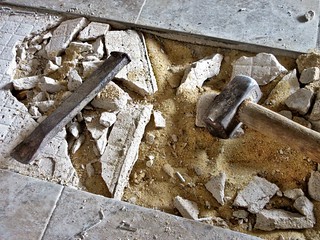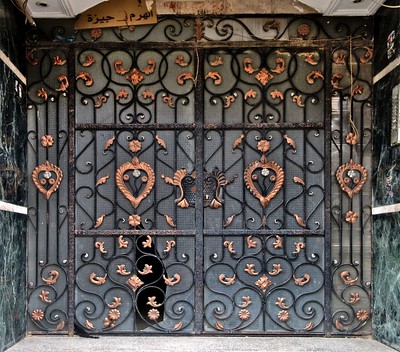It turns out that we did not use any of the newly purchased tile described in the previous post. Gentle prying around the edge of the loosest tile released it with no damage. A neighboring tile was easily removed also.
Our tile setter arrived on Friday afternoon, just after prayers, as shops around our area were reopening. We headed first to this cement store.

It wasn't until I looked at the photo that I noticed that the shop is nestled into a small open spot next to a neighborhood mosque. This shop caters to the low volume customer and is happy to break down mortar and grout by the kilogram. We picked up bags of mortar, brown sand and grout (known locally as "white cement."


Our next stop was a small paint and hardware outlet where we purchased a plastic tarp.


The final stop was at a "plastic shop" where we bought a tub suitable for mixing mortar. All told, I was in for about ten dollars at this point.
I was unsure why we needed the brown sand. It turns out that I had missed something during my previous visits to construction sites. I usually have looked closely at the basic framing of the buildings along with electrical and plumbing work without inspecting the tile installation. (You can click on the "construction" tag on this post to see all my previous posts on the subject.) Notice the pile of sand on the floor at this work site below.

Now, you can google "ceramic tile," thinset, thickset and any number of related terms but you will not find a step in the process that says, "spread a bed of sand about two inches thick on the floor, before beginning." As always, we say, "Everything is different in Egypt." - and it truly is.
Chipping away the 3/4 inch of mortar beneath our tiles revealed our bed of brown sand. Obviously, some shifting had taken place. This was a great revelation to me. I have long wondered how cracks could appear in the tile floors of relatively new buildings, such as the new Museum of Egyptian Civilization; I now understand.
With loose tiles popped off, and the mortar chipped out, our man was now able to level out our sand bed and layer in a new mortar bed. He mixed the mortar out on the balcony in a basin and mixing ring that he had supplied, using water from the newly purchased tub.


After replacing four tiles, it was time for tea; then grout was applied to the tile gaps. This guy must be somewhat of a perfectionist, an unusual thing in Egypt, as experienced by us. He just couldn't help himself so he also filled some other gaps in the original improperly grouted tiles. The result seems fine both physically and aesthetically.


Our installer asked for 250 EGP (about $16) for his afternoon's work. I tipped generously but kept the plastic tub. We disposed of the tarp and old mortar in traditional Egyptian fashion. It was thrown over a fence into a vacant lot. Perhaps someday someone else will have to deal with it.
More photos at this Flickr album.
























































